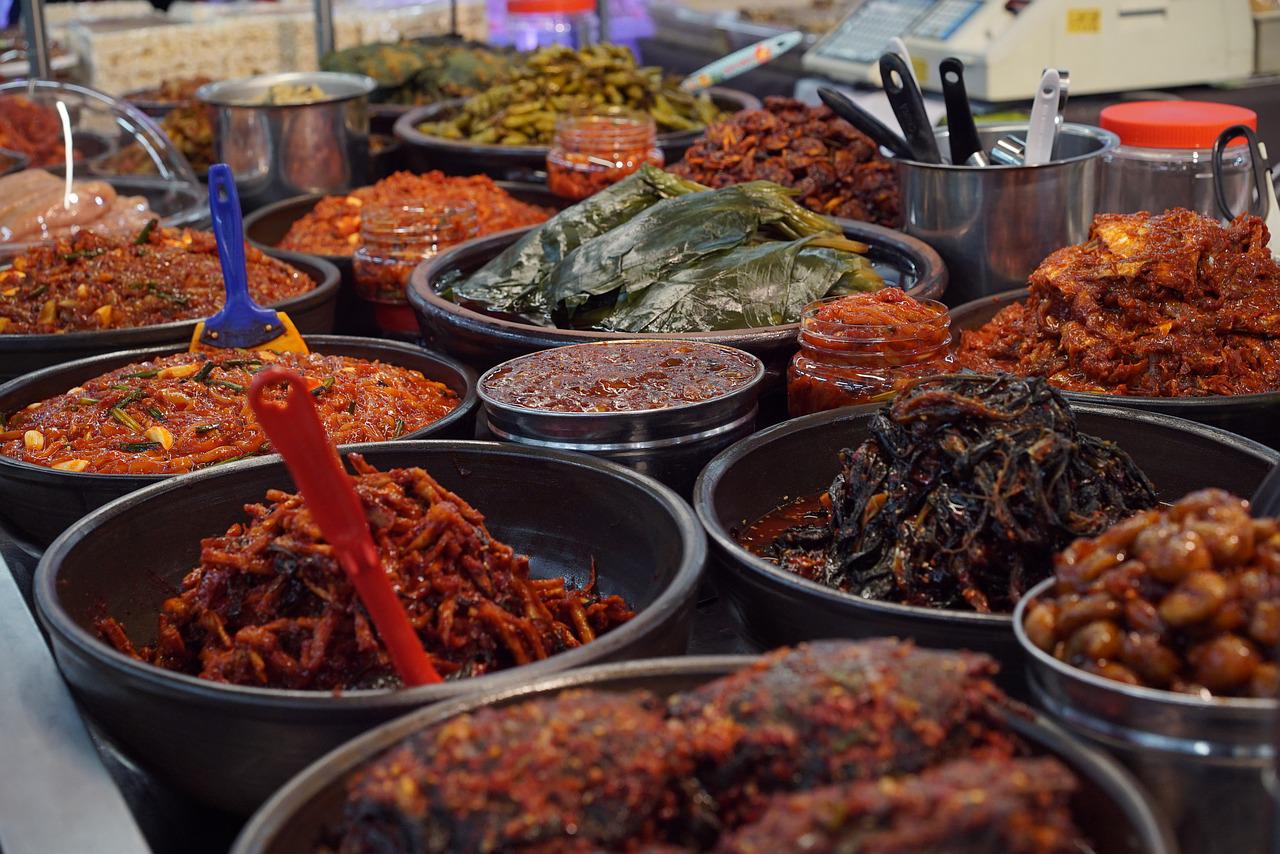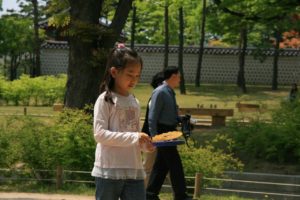음식 eumshig: Basic Korean Food Vocabulary
In this post we’ll build your Korean vocabulary by learning about everyone’s favorite language topic: Korean food terms! Korean food vocabulary will come in handy no matter why you’re learning Korean. First we’ll cover some basic expressions related to food. Then we’ll look at vocabulary for meals. Next we’ll see a lot of basic Korean vocabulary for food and drink. Finally, we’ll wrap up with related vocabulary for utensils and ways to describe your food. Let’s dig in.
배고파요! baegopayo! I’m hungry!
Let’s start to build your Korean vocabulary by learning some expressions that you’ll probably need to know that are related to Korean food vocabulary.
- 배고파요!
baegopayo!
I’m hungry. - 목 말라요.
mog mallayo.
I’m thirsty.
- 뭘 먹고 싶어요.
mwol meoggo shipeoyo.
I want something to eat. - 뭘 마시고 싶어요.
mwol mashigo shipeoyo.
I want something to drink. - 간식 먹고 싶어요.
ganshig meoggo shipeoyo.
I feel like a snack.
저녁 준비 되었어요. jeonyeog junbi doeeosseoyo. Dinner is ready!
You probably want to know how to talk about meals when you’re using Korean food terms. The meals in Korean are: 아침 식사 achim shigsa breakfast, 점심 식사 jeomshim shigsa lunch, and 저녁 식사 jeonyeog shigsa dinner. A snack is 간식 ganshig. Dessert is 후식 hushig.
- 아침 식사는 뭐예요?
achim shigsa-neun mwoyeyo?
What’s for breakfast? - 점심 식사는 뭐예요?
jeomshim shigsa-neun mwoyeyo?
What’s for lunch? - 저녁 식사는 뭐예요?
jeonyeog shigsa-neun mwoyeyo?
What’s for dinner? - 후식은 뭐예요?
hushig-eun mwoyeyo?
What’s for dessert? - 아침을 일찍 먹어요.
achim-eul iljjig meogeoyo.
I eat breakfast early. - 점심을 동료들과 먹어요.
jeomshim-eul donglyodeulgwa meogeoyo.
I eat lunch with colleagues. - 저녁을 가족들과 먹어요.
jeonyeog-eul gajogdeulgwa meogeoyo.
I eat dinner with my family.
뭐를 먹어요? mwo-reul meogeoyo? What are you eating?
Now let’s see some basic Korean vocabulary related to foods and beverages. We’ll divide these Korean food terms into sections.
Korean Food Vocabulary: Carbs and Protein
- 빵 ppang bread
- 쌀 ssal, 밥 bab rice
- 파스타 paseuta pasta
- 국수gugsu noodles
- 고기 gogi meat
- 닭 dag chicken
- 소고기 sogogi beef
- 돼지고기dwaejigogi pork
- 햄 haem ham
- 양고기 yanggogi lamb
- 두부 dubu tofu
- 생선 saengseon fish
- 해물 haemul seafood
- 새우 saeu shrimp
- 랍스터 labseuteo lobster
- 게 ge crab
- 오징어 ojing-eo squid
- 대합daehab clam
More Korean Food Vocabulary: Vegetables, Fruit, Dairy
- 채소 chaesu vegetables
토마토 tomato tomato - 양파 yangpa onion
- 마늘 maneul garlic
- 상추 sangchu lettuce
- 시금치 shigeumchi spinach
- 아스파라거스aseupalageoseu asparagus
- 양배추 yangbaechu cabbage
- 버섯 beoseot mushroom
- 오이 oi cucumber
- 피망 pimang pepper (as in bell)
- 고춧가루 gochugaru chili pepper
- 과일 gwail fruit
- 사과 sagwa apple
- 배 bae pear
- 복숭아 bogsunga peach
- 오렌지 oraenji orange
- 레몬 raemon lemon
- 포도 podo grape
- 딸기 ddalgi strawberry
- 바나나 banana banana
- 견과 gyeongwa nut
- 땅콩 ddangkong peanut
- 씨 sshi seed
- 밀 mil wheat
- 시리얼 shirieol cereal
- 소금 sogeum salt
- 후추 hocha pepper
- 참깨 chamkkae sesame
- 꿀 kkul honey
- 설탕 seoltang sugar
- 간장 ganchang soy sauce
- 고추장gochujang gochujang, fermented chili paste
- 계란 gyeran egg
- 우유 uyu milk
- 치즈 chiseu cheese
- 버터 beoteo butter
Korean Food Terms for Drinks, Sweets, and More
- 물 mul water
- 차 cha tea
- 커피 keopi coffee
- 와인 wain wine
- 맥주 maekju beer
- 두유 doyu soy milk
- 주스 juseu juice
- 아이스크림 aiseukeurim ice cream
- 케이크 keikeu cake
- 파이 pai pie
- 쿠키 kuki cookie
- 사탕 satang candy
- 먹다 meogda to eat
- 마시다 mashida to drink
- 요리하다 yorihada to cook
- 맛보다 matboda to taste
- 밥을 많이 먹어요.
bab-eul mani meogeoyo.
I eat a lot of rice. - 아침에 커피나 차를 마셔요?
achim-e keopi-na cha-reul masheoyo?
Do you drink tea or coffee in the morning? - 요리를 참 잘해요.
yori-reul cham jalhaeyo.
You cook very well!
냅킨 좀 주시겠어요? naebkin jom jusigesseoyo? Could I have a napkin, please?
Now that you know some basic Korean food vocabulary, let’s see some phrases that will come in handy when you’re ordering food. Some vocabulary related to Korean food terms is: 접시jeobshi plate, 그릇geuleut bowl, 칼kal knife, 수저sujeo spoon, 포크pokeu fork, 젓가락jeotgalag chopsticks, 컵keob cup, 유리컵yulikeob glass, 냅킨 naebkin napkin.
- 냅킨/포크/나이프/젓가락 주실래요?
naebkin/pokeu/naipeu/jeosgalag jusillaeyo?
Could I have a napkin/fork/knife/spoon/chopsticks? - 물한잔 주실래요?
mulhanjan jusillaeyo?
Could I have a glass of water? - 포크, 칼, 수저가 어디 있어요?
pokeu, kal, sujeoga eodi isseoyo?
Where are the forks, knives, and spoons? - 포크, 칼, 수저는 서랍에 있어요.
pokeu, kal, sujeoneun seolab-e isseoyo.
The forks, knives, and spoons are in the drawer. - 깨끗한 유리컵은 캐비닛에 있어요.
kkaekkeutan yulikeob-eun kaebinis-e iss-eoyo.
The clean glasses are in the cabinet. - 커피 컵은 선반에 있어요.
keopi keob-eun seonban-e isseoyo.
The coffee cups are on the shelf. - 나무 젓가락 아니면 쇠 젓가락을 쓰세요?
namu jeotgalag animyeon soe jeotgalag-eul sseuseyo?
Do you use wooden or metal chopsticks? - 냅킨 좀 주시겠어요?
naebkin jom jusigesseoyo?
Could I have a napkin, please?
음식이 어때요? eumshig-i eottaeyo? How’s your food?
Let’s close with some Korean vocabulary that you can use to talk about your food: köstlich delicious; salzig salty; süß sweet; bitter bitter; sauer sour.: 맛있어요 mashisseoyo delicious, 짜요jjayo salty, 달아요dalayo sweet, 써요sseoyo bitter, 시어요 shieoyo sour.
- 맛있어요.
mashisseoyo.
It’s delicious. - 이 음식은 훌륭해요.
eumshig-eun hullyunghaeyo.
This food is excellent. - 너무 뜨거워요.
neomu tteugeowoyo.
It’s too hot. - 너무 차요.
neomu chayo
It’s too cold. - 너무 달아요.
neomu dalayo.
It’s too sweet. - 너무 짜요.
neomu jjayo.
It’s too salty. - 싱거워요.
shinggeowoyo.
It’s tasteless/bland. - 너무 익었어요.
neomu inyeosseoyo.
It’s overcooked. - 덜 익었어요.
deol ingyeosseoyo.
It’s undercooked. - 기름져요.
gileumjyeoyo.
It’s oily/greasy.
Learn Korean with the Language Garage
We hope you’ve enjoyed growing your Korean vocabulary with some Korean food terms. If you’d like to learn more, check out our other posts on Korean language, culture, and more. And if you’re looking for convenient and affordable live Korean lessons with a real teacher, check out The Language Garage. Our lessons are given online in a virtual classroom, so it doesn’t matter where you live or work – we can come to you. And we have flexible options, with a free trial so that you can decide if there’s a fit. Check us out!
Image by tommy pixel from Pixabay






